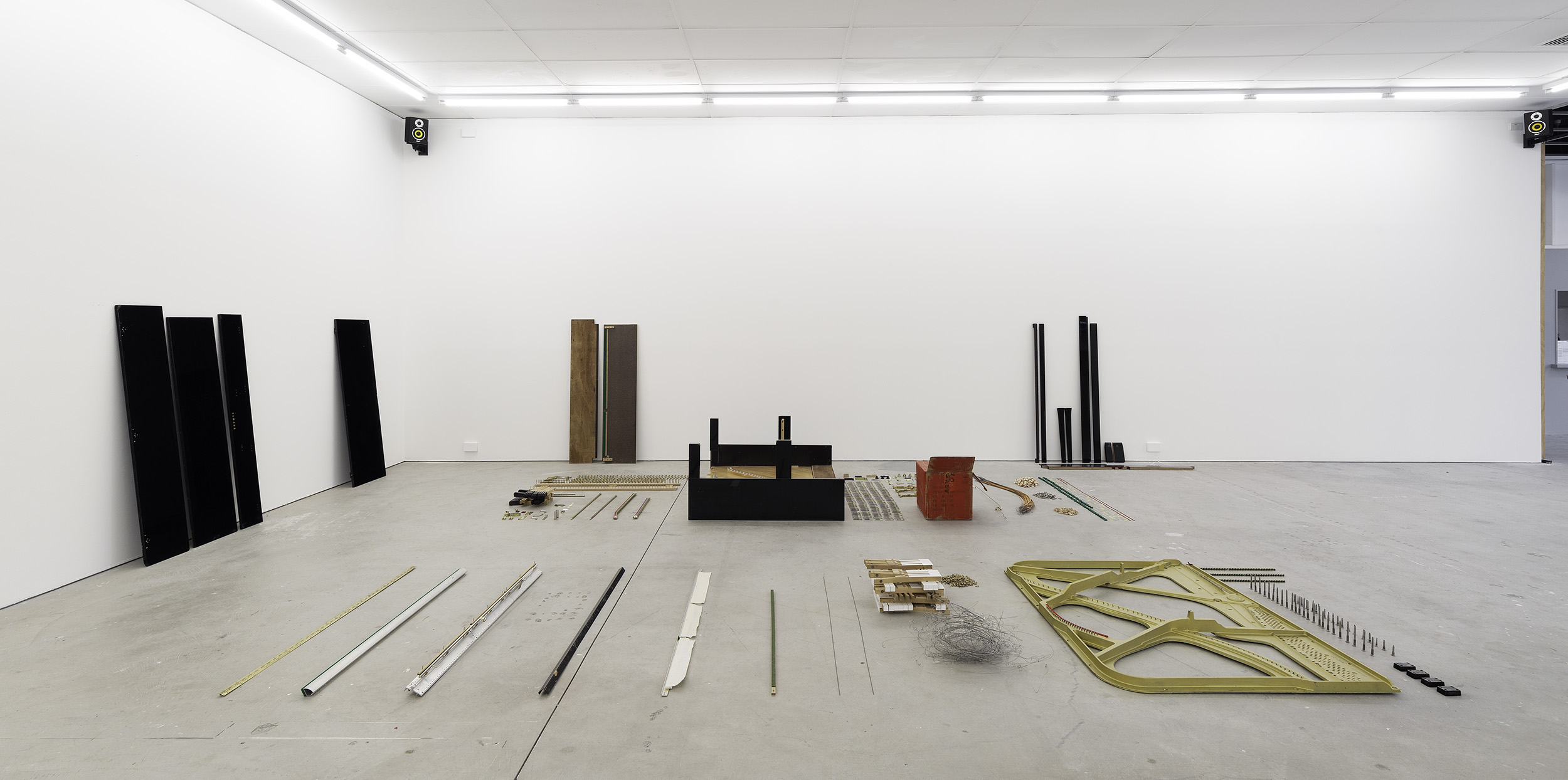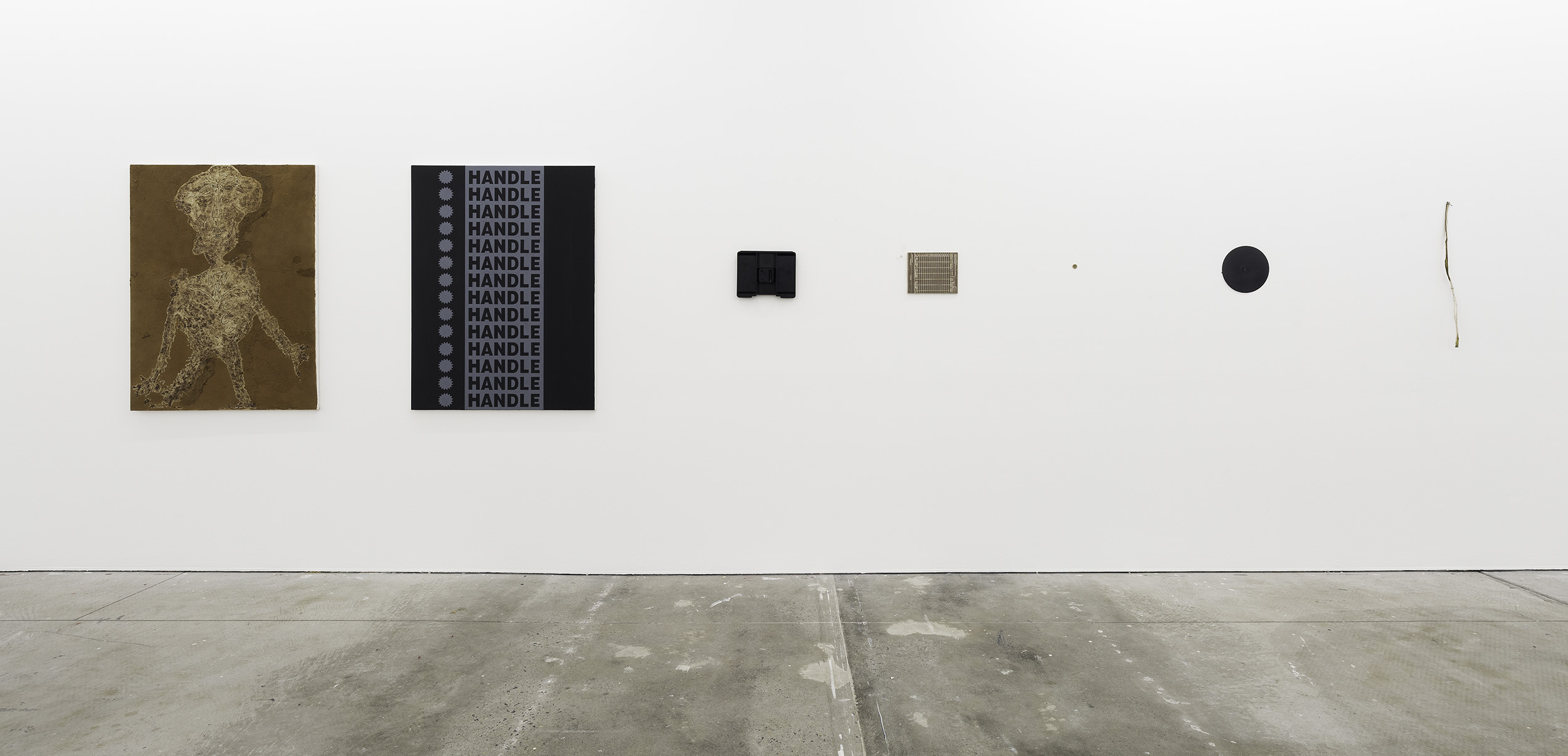Octopus 23: The Field
Declan Fry
Entering Gertrude Contemporary, I am told by a member of the gallery’s staff that Nicola Blumenthal’s Silver Objects (2023) saw ten iterations before opening day. Ten iterations. I’m sorry you missed it, she tells me. I look up: the quiet menace of Ming Ranginui’s slay Belle (2022), a playfully violent axe-as-bow fashioned from satin, hangs above us, waiting to determine what might be eviscerated and what might be kept.
A unit of measurement: this is The Field’s curatorial framework. Or part of it. (A demarcation, which is another unit of measurement.) I’ve probably written and rewritten this opening ten times. (Which opening? Is this still the opening? Here? This? How might I tell you about those other openings? In one, I would have told you about the woman who very kindly explained and clarified the exhibition to me. How would I have described her? Too late; I’ve already said she was very kind.)
Speaking of sayings, they say some artists, not unlike convivial gallery staff, are generous hosts. They want to treat you to the nice crockery. Others go pottering for hours in the kitchen, emerging occasionally to ask if you want anything to drink, but also to inform you that the options are limited. Give me instead something like Gertrude Contemporary: somewhere you can see out and those on the outside may see in, a two-way conversation. (Is that a tautology? Or is it an intentional repetition, a restatement of fact acknowledging that you, dear reader, are over there and I am over here?)

A limited number of options also constitutes a unit of measurement. It presupposes alternatives. Ten iterations, more, less? Given the work of addition and subtraction is never done, let me offer my addition.
I look at Blumenthal’s Silver Objects and find myself thinking of Sydney Road. Near the main drag stands a dissolved structure. A no-longer building. You can go and see it if you like. Once it housed a printing business: Currency Print & Corporate Communications. Victoria’s only First Nations printing company. I worked there.
When the business moved, the building was torn down. We packed up all of Currency’s old publications. Boxes were piled high with books published by Black Pepper in North Fitzroy, the poetry of Emma Lew and Jordie Albiston; old issues of Overland, Jeff Sparrow writing circa-2000; a phone book listing the contact details of Helen Garner and Peter Carey; a guide to “planting indigenous” published by the Blackburn and District Tree Preservation Society and the City of Whitehorse in 2000; a National Gallery brochure entitled William Barak: Bridge Builder of the Kulin; calendars of years that would no longer arrive; the newsletters of communities that had gone the same way.
Silver Objects reminds me of this accumulation of material at Currency Communications. It has weathered the decades, and spoke to other units of measurement (the calendar, the newsletter, the poem). I took some of Currency’s books home. Perhaps, like Blumenthal, I might one day subtract from my collection, donating to the few secondhand stores that still take books (although I know of only one) or to prisons (M., the author, once recommended this). Maybe I will add to it. In the evening head to Savers and, watching the daily ritual of cars being towed on Sydney Road—losing something that once put distance between you and wherever you had come from, and which now is being taken further from you—think about how even when something is gone, it remains. How disappearance yields permanence.
In the William Barak brochure’s opening, Aunty Joy Wandin Murphy writes:
Ober der
Which way you going
this way, that way
how long it takes
from ober der to over here
doesn’t matter
you be ober der soon
In Blumenthal’s piece rust blooms across sheet metal; a case of luggage calls out for a traveller to take it away (and mostly reminds me I am staying put, although it also makes me think of bombed-out cars emptied from the inside and blossoming with rust all over Wongatha country—Leonora and Laverton, Coolgardie and Kalgoorlie—their passengers long since gone). I look at Silver Objects from different angles—from here, from there—varying my lines of sight. Trying always to avoid the mirrors; I don’t want to see myself reflected there. Who would? Who wants to know if they are not where they should be?
Another aspect of Blumenthal’s arrangement: it is claustrophobic. An overturned shopping trolley almost grazes a dark teak sideboard. Objects are stacked against each other or assembled in close proximity, subtracting from the openness of space. I think now that Currency Communications is gone, Sydney Road seems less open too. In material terms loss should widen, should expand. It should make room. Yet somehow it doesn’t. Or perhaps the room is left inside you. A diminishment.
Every day I walk past the space where Currency once stood and think: I carry it. Emptiness. It is a slow practice of accumulation. Waiting until something comes to inhabit the absence. But what will I do with it all then? With the space, I mean—but also with that excess, the time spent mourning and remembering. Where will that go?

If you walk past Currency now—maybe because you’re on your way past the Hardwick Building, maybe because you’ve just come from Ovens Street Bakers—you might see, on the side of a half-collapsed brick wall, the pale graffito of an Aboriginal flag, its red and yellow and black seeping down between the cracks in the brickwork.
Toward the centre of The Field, Dean Cross’s Sad State (1962–2022) vivisects a black Yamaha down to its vitals. The operation reveals the concealed menace of the Japanese manufacturer’s pianos—look at all those teeth! those serrated edges! Metal rods of the smaller keys stick out; felt piano washers arranged in a constellation of colour, red and yellow and green and grey. Things fall apart, yet something appears once they do: an intimate demonstration of craft, the know-how creation demands. It’s a strange currency, a species of knowledge Ikea might once have looked at and said: Let’s simplify. Let’s lose the edges, the nodes, the arrangement, the complexity. (Another assignment of value.)
Although there are limits to that ethos, too. As far as I know, Ikea never tried manufacturing and selling pianos.
Shannon Te Ao’s Hara (2023) recalls the practice of 山水 painting. The first word, shan, means mountain—you can probably see it—and the second, shui, means water (listen to it, hushed and trickling down the page).
In this practice, mountains and rivers collapse together in a monochromatic wash of ink, the outline of one suggesting the other. Misty tricks of morning light. How a foggy day works by suggestion: maybe you see a hill, maybe you see a shoreline, or maybe just all the ink I’ve spilled writing the shore and hill here. I think I see it move, but I tell myself, no, it’s just a perception trick.

Yet the more I try to hold the picture quiet, to keep it still, the more it seems to resist. Not only Hara but also its neighbouring piece, Silver Objects. Something about their inert, discarded quality invites movement. Perhaps the case of luggage will roll again, the sideboard’s doors swing open. And it’s in this way, too, that the image on the left of Hara, a repetition of the one on the right, contains a difference, like a wing or tail or hand in motion. An interruption. Something traced its outline here.
This is what all these deconstructed objects are: traces. (Another unit of measurement: metaphor, metonymy, the assignment of likeness.) What does the trace tell us? It tells us a paradox. Something is here but is no longer here. The life of the piano and its music; the empty suitcase and sideboard; the dark glimmer streaking through Hara. Perhaps their possibilities are expended. Perhaps they are yet to arrive.
Shiraz Sadikeen’s pieces—wage form, clock face, a dollar coin with bone wax embedded, a petty cash box—dismantle items associated with currency, employment, and capital’s demarcations of time into their composite parts (I think of Bobby Hutcherson, whose 1964 album was called Components).

Underscoring The Field is an hour-long composition by Raven Mahon and Mikey Young, Ever Decreasing Circles (2023). It is a long series of ellipses: concentric loops in the treble register, something menacing occasionally clawing its way through the bass. Drops of blooming sound, a little like a vibraphone, pulse and flutter. Maybe I’ve just been listening to too much Bobby Hutcherson lately (although that’s not true; you can never listen to too much Bobby Hutcherson). Ever Decreasing Circles is a kind of music whose horizon is always happily receding. Beneath it, an undercurrent—sometimes a rumbling, as if something below or inside of the tune is broken and trying to rearrange itself.
Perhaps disaggregation, being in pieces, might be a way of refusing to be put together. Or perhaps it might be a way of satisfying another form of completion: rejecting the standard that says here is an excess and here is a lack. Like Bella Besen’s whatever happens happens (…) (2003): an invocation greets you as soon as you enter The Field, printed on silver car vinyl and mounted on a wooden board. Whatever happens, happens. But what? What happens?—was it serendipitous, intended, other?
Here is what I think: it is a tautology. A repetition. But a repetition can be an affirmation, too, a way of giving voice to excess. The faux pas is not an accident or a mistake but occurs by design. It becomes something intentional, asserted. Take it or leave it. Whatever happens, happened. Sorry if you missed it.
Declan Fry is a writer living in Naarm/Melbourne
This review was made possible thanks to the generous support of MERIDIAN SCULPTURE.


